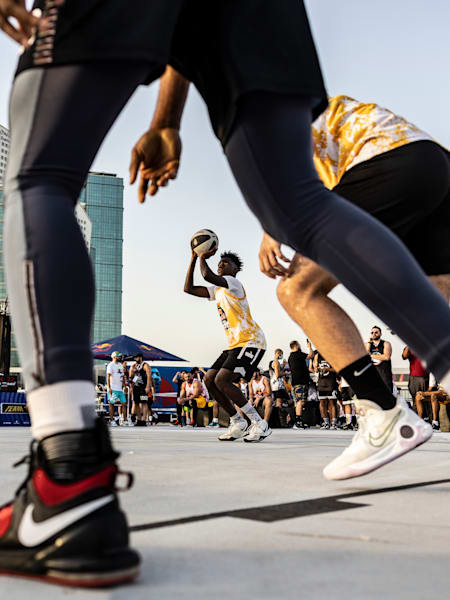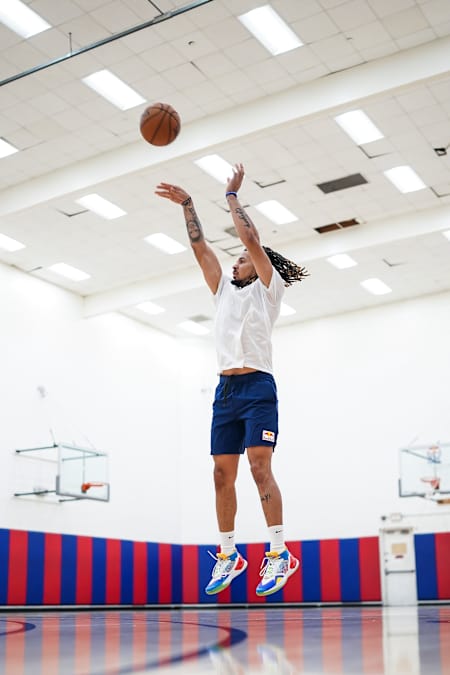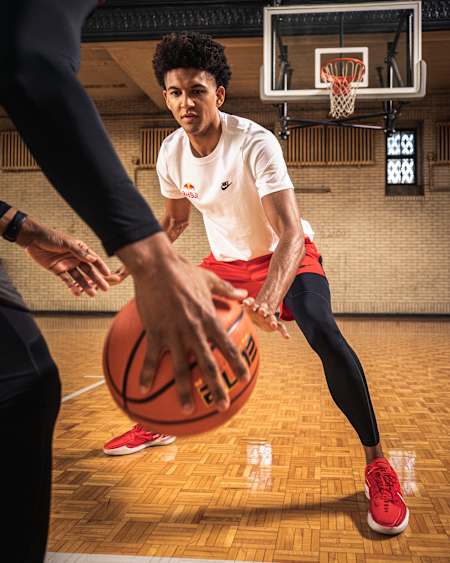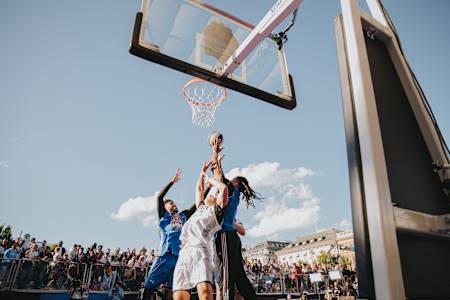
Basketball
Basketball positions explained: what each player does
We’re breaking down each position, looking at key characteristics and fundamental skills.
If you’re looking for ways to level up your basketball skills, there's no better place to start than with the fundamentals of the game: the positions. If you’re looking for a real life tutorial, check out the Red Bull Pro-Am Basketball Classic.
With just five players on the court, each position in basketball has a pivotal role to play both individually and together. To help you bring the most to your basketball team, we’re breaking down each position, looking at key characteristics and fundamental skills.
Back to the Basics: Basketball Positions & Strategy
Before we dive into the specifics, let’s go back to the basics for a moment. Generally speaking, each team is made up of five designated positions: shooting guard, small forward, point guard, power forward and center.
Team players are assigned their position based on a number of factors such as physique, ball handling, passing and shooting skills.
Unlike other team sports, basketball players play both offense and defense, regardless of their assigned position. In fact, the ability to switch between attack and defend is the cornerstone of a good player.
Basketball Positions Explained
The point guard is the core of any team. They’re like the quarterback in football, because they're usually responsible for signal-calling and orchestrating play as the ‘floor general’ or ‘coach on the floor.’ Just follow Red Bull athlete Cole Anthony for a stellar example of how to play Point Guard.
As Anthony sees it, mentality is crucial to success on the court. Early in his professional career he says, “I recognized that there are levels within the NBA. And to get to that highest level, you really do need that insane, intense, consistent work ethic and discipline.”
Even though a point guard can score, they are more of a facilitator. The position gains possession of the ball, passes it to their teammates, and creates scoring opportunities.
The point guard is usually one of the shortest players on the team and boasts a deep knowledge of the game since they’re the one calling the shots.
On defense, the point guard guards an opposing player, trying to block their shots and retain possession of the ball. They try to steal the ball, then create openings for their team to score.
What makes a good point guard?
- Dribbling: Confident dribbling with both hands and faultless handling of the ball is essential.
- Passing: High precision passing the ball at short distances and cross-court.
- Speed and agility: The point guard should bring serious speed and help drive the ball towards the basket.
- Confidence and leadership: Play calling is a central aspect of the Point Guard’s role. Clear, vocal, and incisive communication is essential.
- Team mentality: As a facilitator, point guards need to be conscious of their whole team at all times, directing the play and getting the ball to key players.
01
Shooting Guard
The shooting guard’s primary focus is shooting– and hopefully scoring. They’re usually taller than point guards and may be skilled passers too, although this isn’t a prerequisite. Get to know Red Bull athletes Matisse Thybulle and Donte DiVincenzo if you want to see talented shooting guards.
What does the shooting guard do on offense?
On offense, the shooting guard should do everything to score from a variety of distances and adapt to the play at hand. Typically a shooting guard shoots from the three-point line.
What does the shooting guard do on defense?
On defense, the shooting guard should focus on stealing the ball. They need to be quick to catch rebounds and guard their opponents with agility and speed.
Thybulle attributes his success to his attitude, “defense isn’t something people focus on. There’s a reason there are not so many people doing it. It’s hard work. It’s not sexy and you’re only noticed when you don’t do your job. But I’ve always embraced it.”
What skills and attributes does a shooting guard need?
- Strong shooter: The shooting guard should be a confident shooter.
- Good instincts: They need to be instinctive players, that seek out open spaces and that can break through the opponent’s defense line.
- Confident ball handling: A shooting guard should feel comfortable handling the ball.
- Intuitive at reading space: Shooting guards should be able to read space and use it to their advantage, setting themselves up to score.
02
Small Forward
The small forward should be a highly versatile and adaptable player. They need a cross-section of skills because they’re heavily involved in both offense and defense.
Small forwards, as their name suggests, are smaller players but they’re usually still taller than the forward or center. They need enough height and strength to face off a diverse range of players. They need to be reactive and dynamic players that are able to transition between plays quickly. An iconic small forward is Red Bull athlete Jaylen Brown.
What does a small forward do on offense?
Small forwards have a diverse role. On offense, they should be looking to gain possession, open space, set up their teammates by setting screens and potentially even score. On defense, small forwards should be focused on rebounds and defending their counterparts.
What are the key characteristics of a small forward?
- All-rounder: A small forward should be somewhat of an all-rounder, ready to adapt their game and do a bit of everything.
- Confident ball handling and good passing: Small forwards should be steady with the ball and able to pass it with accuracy.
- Strong mid and short-range shots: A small forward should be able to score from the three-point line and from close range.
- Agility: Small forwards guard a whole array of positions, meaning they may be put against taller and stronger players. Speed is key.
- Speed: Small forwards need to grab rebounds with speed, as well as guard their opponents nimbly.
03
Power Forward
The power forward’s role mirrors the center’s quite closely. One of their biggest responsibilities is rebounding, and they play a big role in their team’s defensive strategies.
Power forwards are strong and typically one of the tallest players on the team. Their role is usually fairly physical, hence their title. It requires them to have substantial strength. WNBA star and Red Bull athlete Breanna Stewart says a power forward has to stand their ground. “It gets physical when you’re playing on the post, playing down low, banging with the bigger bodies.”
What does a power forward do on offense?
On offense, the power forward should look to shoot and score, where possible. They should also be looking to get those rebounds and set up a second chance to score.
What does a power forward do on defense?
On defense, the power forward fiercely guards the post and blocks their opponents, closes passing lanes, and is always looking to grab rebounds.
What skills and attributes does a power forward need?
- Confident ball handling: Power forwards can’t falter once they’ve got their hands on the ball.
- Strong at securing rebounds: Power forwards should have no problem gaining possession of rebound balls.
- Strong jump shot: When the opportunity presents itself, power forwards should be able to use their jump shot.
- Good screen setting: The ability to set up their team’s ball handlers.
- Keeping possession: It’s not just about getting possession of the ball but keeping it.
- Strong defense: Shot blocking and dodging their opponent should be second nature. It helps that they’re taller than their counterparts, too.
- Agility: With the varied responsibilities of a power forward, speed and strength are essential.
04
Center
The center is usually the tallest player on the team. They play near the basket in the low post area and take the jump ball at the beginning of the game.
Their height is their biggest asset. A center isn’t necessarily the most skilled player when it comes to dribbling or shooting, but leveraging their height they’re able to double down on rebounds and block their opponents. Top centers include Red Bull Athlete Blake Griffin, who also plays power forward.
What does the center do on offense?
On offense, the center focuses on rebounds and scoring. They should be skilled at creating opportunities for themselves to score and dunk the ball. They should also set screens, allowing their teammates to move into space for shooting.
In addition, centers need to be confident posting up, which means playing facing away from the basket and moving to score once they gain possession.
What does the center do on defense?
On defense, the center is crucial. They’re the last obstacle standing between the opponent and a two point shot. The center should protect their post, block their opponent, and grab rebounds.
What skills and attributes does a center need?
- Good level of fitness: A center’s role is truly physical, so fitness and strength are essential.
- Fierce rebounds: Centers need to be quick and agile to grab critical rebounds.
- Height: If you want to play center, you need to be tall.
- Blocking: Centers should be able to block opponents with aggression.
- Shooting from the low post: Centers need to be skilled at scoring ‘down low’ as well as posting up.
It’s Time To Shoot YOUR Shot
Though it’s easy to assume that the center or the point guard might be the big players, in reality, with only five players on the basketball court, each player is as important as the next. The key to high-level gameplay is abandoning concepts of hierarchy and working like a well-oiled machine, as five parts of a whole.
As Red Bull athlete and basketball’s most sought-after shooting coach Lethal Shooter (a.k.a. Chris Matthews) puts it ‘like anything, if you want to get better, it’s OK to have someone teach you how. Because no person is perfect.”










